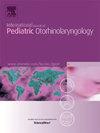Treatment of acute and chronic facial palsy in children and adolescents: Prognostic factors for the outcomes
IF 1.2
4区 医学
Q3 OTORHINOLARYNGOLOGY
International journal of pediatric otorhinolaryngology
Pub Date : 2025-02-19
DOI:10.1016/j.ijporl.2025.112277
引用次数: 0
Abstract
Introduction
Pediatric facial palsy is a rare disease. There is a lack of data on the outcome of peripheral acute facial palsy (AFP) or chronic facial palsy (CFP) in children and adolescents after treatment and on the prognostic factors.
Methods
A retrospective study was conducted in a university facial nerve center. Clinical data was analyzed for their impact on probability of recovery or functional improvement using univariable and multivariable statistics.
Results
84 F P patients (range: 0–18 years, 35 % AFP, 17.9 % flaccid CFP; 29.8 % synkinetic CFP) treated 2003–2021 were included. All AFP received intravenous prednisolone therapy (PT). 56 % of patients with synkinetic CFP were treated with electromyography biofeedback facial training (EBFT). Facial nerve reconstruction (FNR) was the most common treatment (40 %) for flaccid CFP. 82.8 % of AFP fully recovered. Synkinetic CFP showed improvement in 60 %. 26.7 % of flaccid CFP patients showed improved facial mobility. AFP patients with a Stennert Index (SI) > 6 (p = 0.024), House Brackmann scale (HB) > III (p = 0.034), or PT started more than 96 h after onset had worse outcomes. CFP patients with SI motor function >4 (p = 0.002), total SI > 6 (p = 0.015), HB > III (p = 0.002), or ipsilateral loss of the stapedius reflex (p = 0.021) had a lower probability of improvement.
Conclusions
PT should ideally begin within 96 h after the onset of AFP in children to maximize recovery chances. The severity of FP is a key prognostic factor for recovery. Like adults, children with synkinetic CFP benefit from EBFT. Guideline-based therapies for adults seem to be also effective for children and adolescents.
儿童和青少年急性和慢性面瘫的治疗:预后因素
小儿面瘫是一种罕见的疾病。目前缺乏关于儿童和青少年周围性急性面瘫(AFP)或慢性面瘫(CFP)治疗后的预后和预后因素的数据。方法对某高校面神经中枢进行回顾性研究。采用单变量和多变量统计分析临床数据对恢复概率或功能改善的影响。结果84例F - P患者(年龄范围:0 ~ 18岁,AFP占35%,弛缓性CFP占17.9%;包括2003-2021年治疗的29.8%的synkinetic CFP。所有AFP患者均接受泼尼松龙静脉治疗。56%的共动性CFP患者接受肌电生物反馈面部训练(EBFT)治疗。面神经重建(FNR)是弛缓性CFP最常见的治疗方法(40%)。82.8%的AFP完全恢复。联合动力CFP改善了60%。26.7%的弛缓性CFP患者面部活动能力改善。伴有Stennert指数(SI)的AFP患者6 (p = 0.024), House Brackmann量表(HB) >;III期(p = 0.034)或PT开始时间超过96小时的患者预后较差。CFP患者SI运动功能>;4 (p = 0.002),总SI >;6 (p = 0.015), HB >;III (p = 0.002)或同侧镫骨反射丧失(p = 0.021)改善的可能性较低。结论小儿AFP发病后96 h内应开始spt治疗,以获得最大的康复机会。FP的严重程度是恢复的关键预后因素。与成人一样,患有联合动力性CFP的儿童也受益于EBFT。针对成人的基于指南的治疗方法似乎对儿童和青少年也有效。
本文章由计算机程序翻译,如有差异,请以英文原文为准。
求助全文
约1分钟内获得全文
求助全文
来源期刊
CiteScore
3.20
自引率
6.70%
发文量
276
审稿时长
62 days
期刊介绍:
The purpose of the International Journal of Pediatric Otorhinolaryngology is to concentrate and disseminate information concerning prevention, cure and care of otorhinolaryngological disorders in infants and children due to developmental, degenerative, infectious, neoplastic, traumatic, social, psychiatric and economic causes. The Journal provides a medium for clinical and basic contributions in all of the areas of pediatric otorhinolaryngology. This includes medical and surgical otology, bronchoesophagology, laryngology, rhinology, diseases of the head and neck, and disorders of communication, including voice, speech and language disorders.

 求助内容:
求助内容: 应助结果提醒方式:
应助结果提醒方式:


